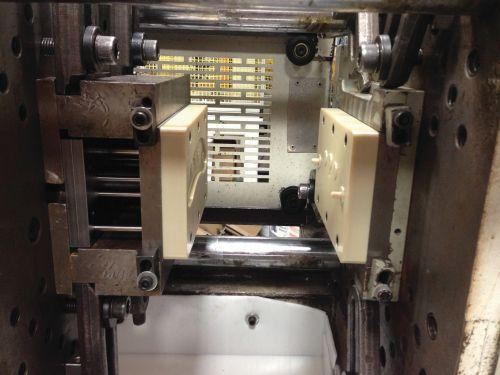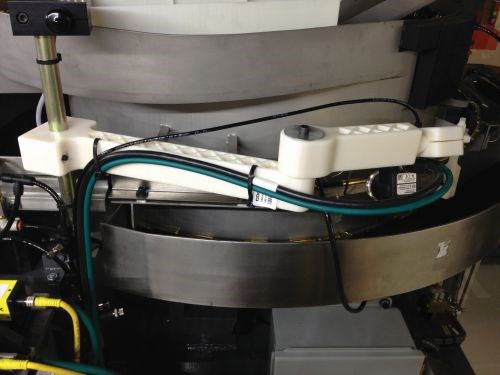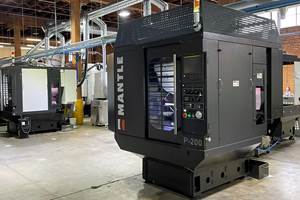Everyday AM
It’s not just for prototyping. Additive manufacturing can help with the manufacturing side of your business as well.
From a piece of automation that helps hold a fishing lure container in a die press to a simple milling fixture for a secondary operation on a molded part to a fixture to aid production in packaging assembly, Premier Source of Brookings, South Dakota, proves every day that there are strong manufacturing reasons to use additive manufacturing (AM).
Although its parent company, Falcon Plastics, boasts 200+ employees, Premier Source is 27 employees strong and an avid fan of AM for everyday production work.
Spawned originally to work with small entrepreneurs and on new product development for existing customers, Premier’s toolroom took over all moldmaking responsibilities for the parent company as well as low-volume custom injection molding. With that came custom automation work.
The company cut its teeth in AM on rapid prototyping (RP) and eventually began to farm out enough of it that it became viable for ownership to bring the technology in-house and recoup some of the costs. It was then that Premier started to realize AM’s potential for many applications—for both itself and its customers.
“It’s not just rapid prototyping,” says Joel McCue, engineering manager. “You need to look at this as assisting you with the manufacturing side of your business.”
Machine Technology
Premier bought its first uPrint 3D printer from Stratasys in 2010 and later bought a second one. The machine features a 6 × 8-inch build envelope and is well-suited for tiny parts such as small workholding devices and assembly fixtures for injection molding work.
In 2011, Premier added a Fortus production system because of the need for different materials and larger 3D-printing builds. Today, the company has two Fortus printers, which McCue says enables Premier to produce relatively large, elaborate fixtures involving high strength and forces, along with tight repeatability and accuracy. If the company needs to build something that requires precision, it always runs on the Fortus 400.
Meanwhile, if a part requires texturing and sandblasting, the mold shop will print off a mask on the uPrint, because this machine is capable of a fast turnaround. According to McCue, the shop follows this guideline: If something small and cheap is needed fast, use the uPrint; if it’s more complicated or larger, use the Fortus.
McCue says the shop made the jump to the larger, production-oriented machine after a customer started using the so-called RP parts not as prototypes, but as disposable tooling fixtures.
“It worked really well, but if we got really aggressive we were still breaking the parts,” McCue says. The shop began to look at the larger machine because of its ability to print in Ultem, a stronger material.
Now, the company continues to find new fixturing and workholding applications. “With AM, you can see a concept in CAD, and if you want to try it out, you can have a fixture in hours,” McCue says. That compares with days or weeks for conventional fixture making.
In the Toolroom
In terms of fixture production, organization tools and moldmaking, AM has taken Premier to a
new level.
“If we are milling plastic parts, it’s great,” McCue says. “If it’s a curved, organic or round part that is not easy to hold, we can use 3D printing to make really great fixtures.” Often, these are fixtures that would not be practical to produce any other way.
Premier uses AM frequently within the custom automation side of its business. McCue says he consistently uses it to design fixtures to hold pieces of automation such as L brackets, sensor and camera brackets. The company also aims to apply AM for some 5S concepts, creating organization tools for cleaning up the production area.
“With AM, you can create a place for your crescent wrench, a place for your screwdriver, and basically strap those kinds of tools to the sides of the machines,” McCue says. The shop is just beginning to explore AM for this kind of customized hand tool management within its own facility.
On the moldmaking side, Premier has used 3D printing via the Stratasys machines’ fused deposition modeling (FDM) process to run off prototype mold tools for a customer, printing the molds from Ultem and then creating a master unit die (MUD) set. After printing A and B halves, the company successfully ran 30-40 polyethylene parts for the customer using this tooling. Making low-volume injection molds in this way has helped the company win work from customers unable to justify $5,000 for a first run of molded parts.
In fact, the company’s first attempt at molding parts this way involved a customer that didn’t know how the mold was made. Premier took the risk, ready to use conventional tooling to produce the parts if the RP mold failed.
Buy-in/Training
McCue says a couple of factors have helped with AM’s adoption at Premier. One is Advanced Technology Systems, the representative for Stratasys and its line of 3D printers.
“AM is about getting in there and doing it, and then being able to call a ‘Matt’ to run things by and hear explanations on what the machine does and why one way is better than the other,” McCue says. “Matt” is Matt Havekost, Advanced Technology’s director of sales.
Also, he says, in the design area, Premier has a young crew of employees—mostly in their 20s and 30s. This has made the leap to designing for AM (as opposed to designing for more conventional processes) much easier. Meanwhile, the mold makers have come to appreciate AM’s application in fixturing because it often saves them from having to come up with a convoluted fixture device and therefore allows them to focus more on the part.
McCue says the group that still has to be engaged or persuaded now is the customers who have not yet seen AM at all, or those who don’t yet appreciate how to think differently to design tools for AM.
Engineers become accustomed to every part beginning as a big block, McCue says. “Now, we need to explain that ‘No, that is wasted material, time and cost; use AM and only put material where you need it.’ It’s a real re-education.”
Adding On
“Our next machine will be a metal laser sintering machine. This could help us tremendously on the moldmaking side of things, reducing leadtimes,” he says.
It would do this by eliminating steps, McCue says. He would just design the mold component and print it. There would be no need to create electrodes and write the CAM program to go on the mill. Machining could make the plates and the pockets, while the detail could go into the sintered parts.
The difficult part of this plan will be justifying the machine. The price of a metal AM machine—well over a half million dollars—equals a lot of mold inserts, he says.
But the same challenge in justification is there for plastics AM machines as well. “I don’t see every manufacturer having a machine in-house,” McCue says. “If they are only going to buy $10,000 worth of parts a year, why buy a $100,000 printer? Just farm it out. We want to be the place that can do this work for them and, at the same time, use AM for ourselves.”
Related Content
Mantle: 3D Printed Molds Address Plastics Industry Lead Time and Skills Shortage
Company now shipping production systems. Steel mold tooling from its TrueShape process can be printed, shaped and sintered in days, and with fewer steps, compared to weeks of lead time for molds made conventionally.
Read MoreThe Connector Conundrum: 3D Printed Mold Tooling’s Role in Innovation
ReelView Fishing faced an electronics obstacle in the development of its new technology for underwater video. Additive manufacturing for moldmaking allowed for the speed necessary to iterate to a solution. How inventors and invention will benefit from new ways of obtaining production-ready tooling.
Read MoreRobot Vs. Gantry for Large-Format Additive Manufacturing (Includes Video)
Additive Engineering Solutions, specialist at 3D printing very large parts and tools on gantry machines, now also uses a robot for large-format AM. Here is how the robot compares.
Read MoreChuck Jaws Achieve 77% Weight Reduction Through 3D Printing
Alpha Precision Group (APG) has developed an innovative workholding design for faster spindle speeds through sinter-based additive manufacturing.
Read MoreRead Next
Alquist 3D Looks Toward a Carbon-Sequestering Future with 3D Printed Infrastructure
The Colorado startup aims to reduce the carbon footprint of new buildings, homes and city infrastructure with robotic 3D printing and a specialized geopolymer material.
Read MoreProfilometry-Based Indentation Plastometry (PIP) as an Alternative to Standard Tensile Testing
UK-based Plastometrex offers a benchtop testing device utilizing PIP to quickly and easily analyze the yield strength, tensile strength and uniform elongation of samples and even printed parts. The solution is particularly useful for additive manufacturing.
Read MorePostprocessing Steps and Costs for Metal 3D Printing
When your metal part is done 3D printing, you just pull it out of the machine and start using it, right? Not exactly.
Read More
























